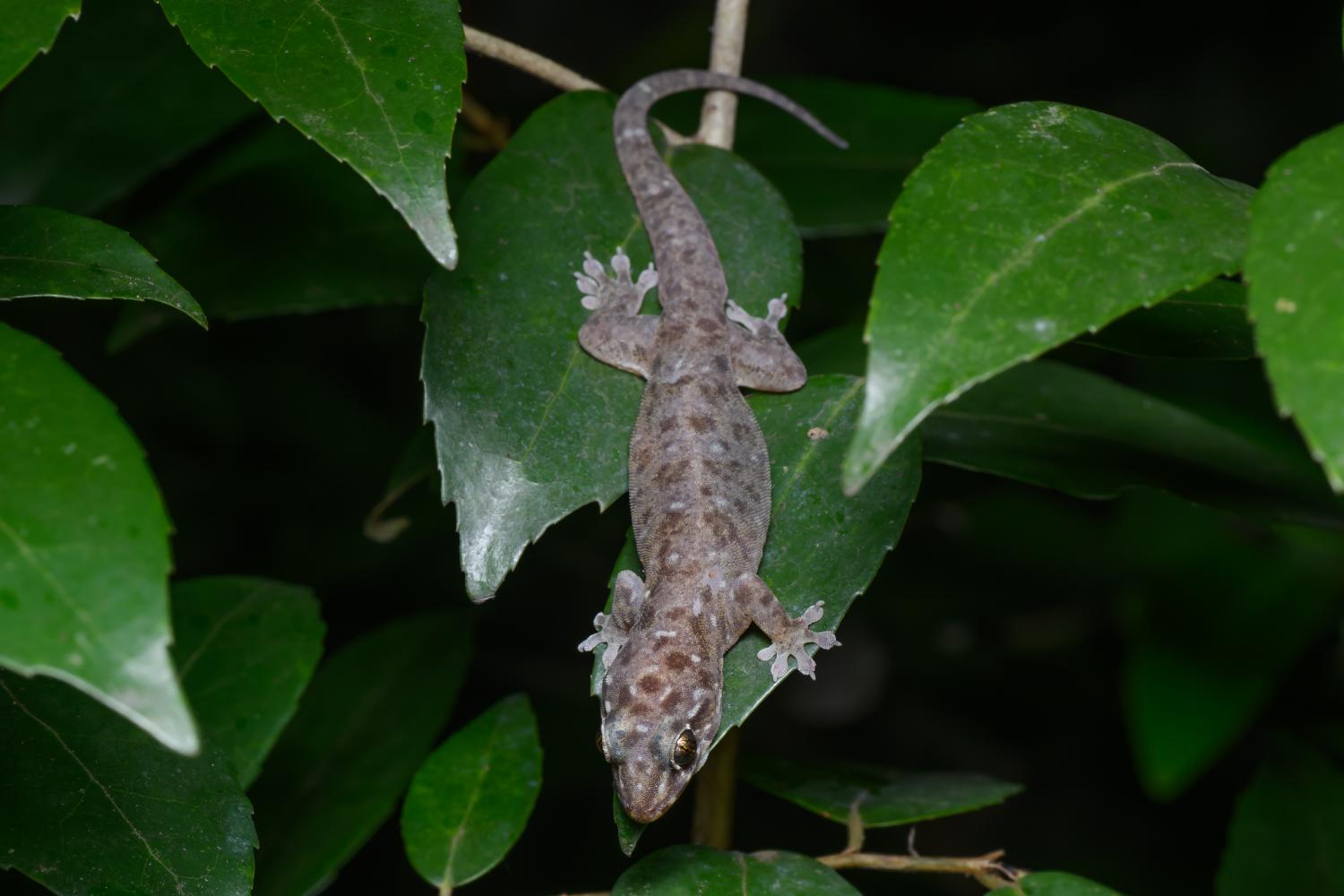Species of Thailand
Stump-tailed four-clawed gecko
Gehyra mutilata
Arend Friedrich August Wiegmann, 1834
In Thai: จิ้งจกหินสีจาง
The four-clawed gecko (Gehyra mutilata, also known as the stump-toed gecko, tender-skinned house gecko, sugar lizard, or Pacific gecko, or butiki) is a wide-ranging lizard that is probably native to Southeast Asia. It has made its way to several areas of the world including Sri Lanka, Indochina, and many of the U.S. Pacific Islands. The gecko is somewhat plump, with delicate skin. The skin is usually colored a soft purplish/pinkish gray with golden spots on younger specimens; these spots eventually fade with age.
Description
Head longer than broad; snout longer than distance between eye and ear-opening, about 1.3 times the diameter of the orbit; forehead with a median groove; ear-opening moderately large, suboval. Body and limbs moderately elongate, depressed, a fold of the skin bordering the hind limb posteriorly. Digits short, more or less webbed at the base; the inferior lamellae angular, divided by a median groove. Upper surface and throat covered with small granular scales, largest and flat on the back. Abdominal scales moderate. Rostral quadrangular, broader than deep, with a median cleft above; nostril pierced between the rostral, the first labial, and three nasals, the upper much the largest and generally in contact with its fellow; 8 or 9 upper and 6 or 7 lower labials; mental moderately large, pentagonal; chin-shields 3 pairs, inner very large, elongate, outer small, frequently broken up into small scales. Femoral pores in a doubly curved line, angular in the middle, 14 to19 on each side. Tail depressed, normally with a sharpish, minutely serrated lateral edge; its upper surface covered with very small flat scales, its lower surface generally with a median series of large transversely dilated scales. Greyish or reddish brown above, uniform or dotted or variegated with darker; lower surfaces uniform whitish.
From snout to vent 2.25 inches; tail 2.25.
Distribution
Ceylon, Burma, Malaysia, The Philippines, Indonesia, New Guinea, Mascarenes and Seychelles, Western Mexico, Maui, Hawaii.
Habits
Like many other geckos, it is very adaptable to its surroundings, although it usually prefers woodlands, rocky areas, and human dwellings. It is also very common on sand beaches in Hawaii, where it is considered an invasive species. The geckos make themselves at home in people's houses, don't seem to mind the humans living beside them; many people don't mind the geckos either, perhaps because, being a nocturnally active species that spends much of its time high up on walls and ceilings; they are quite unobtrusive, and because they helpfully prey on household insects.
The species is fairly large for a gecko, reaching up to 12 cm. Its tail can reach almost the entire length of the body.
Like most geckos they are oviparous, i.e. reproduce by laying eggs.
The four-clawed gecko shares with the Tokay gecko an unusual ability (for lizards): it is able to vocalize, making chirping noises reminiscent of a cricket.
This article uses material from Wikipedia released under the Creative Commons Attribution-Share-Alike Licence 3.0. Eventual photos shown in this page may or may not be from Wikipedia, please see the license details for photos in photo by-lines.
Scientific classification
- Kingdom
- Animalia
- Phylum
- Chordata
- Class
- Reptilia
- Order
- Squamata
- Suborder
- Lacertilia
- Family
- Gekkonidae
- Genus
- Gehyra
- Species
- Gehyra mutilata
Common names
- German: Gewöhnlicher Vierkrallengecko
- English:
- Stump-tailed four-clawed gecko
- Common four-clawed gecko
- Stump-tailed gecko
- Stump-toed gecko
- Thai:
- จิ้งจกหินสีจาง
- จิ้งจกบ้านหางอ้วน
Photos
Please help us review our species pages if wrong photos are used or any other details in the page is wrong. We can be reached via our contact us page.
Range Map

- Ao Luek District, Krabi
- Ban Lat District, Phetchaburi
- Cha-Am District, Phetchaburi
- Huai Kha Khaeng Wildlife Sanctuary
- Huai Yang Waterfall National Park
- Kaeng Krachan District, Phetchaburi
- Kaeng Krachan National Park
- Khao Pu - Khao Ya National Park
- Khao Sam Roi Yot National Park
- Khao Sok National Park
- Khao Yai National Park
- Mueang Krabi District, Krabi
- Phi Phi Islands
- Sakaerat Environmental Research Station
- Tarutao National Marine Park
- Thale Ban National Park
- Thung Yai Naresuan Wildlife Sanctuary
- Yan Ta Khao District, Trang
- Yong Waterfall National Park


